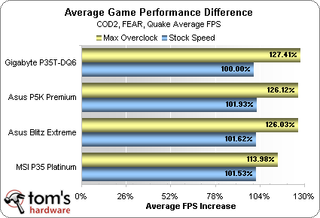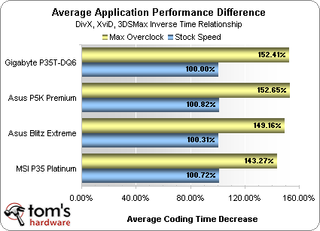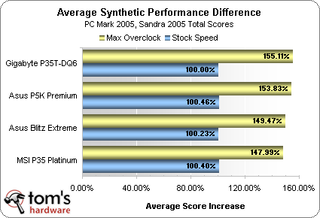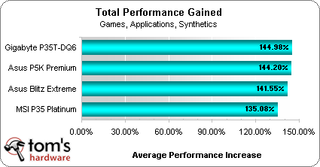Extreme FSB: Taking the E6750 Beyond 4 GHz
Performance Summary
Benchmarks proved the differences between boards, with each taking its own wins. A few averages can help to determine the effectiveness of our 56% CPU overclock. The following performance differences are relative to the lowest-scoring original speed.

An approximate 26% increase in overall gaming performance for the top three boards might not seem so huge given the large increase in CPU clock speed, but we didn't even touch the graphics card's clock settings. Call of Duty 2 was especially graphics bound, which makes the gains in F.E.A.R. and Quake 4 appear all the more impressive.
By not relying on graphics power, applications become a more useful measure of CPU performance. How did they do?

An average performance increase of around 51% for the top three boards is very close to the CPU overclock percentage.
Several synthetic benchmarks included memory tests, which could further enhance our overclocked "performance rating".

Gigabyte's P35T-DQ6 comes very close to its 56% overclock with a 55% performance gain, while Asus' P5K Premium shows just how little we need DDR3 memory at this stage of CPU development.
Combining performance gains across all categories will provide the most realistic estimate of how much faster each system "feels".
Stay on the Cutting Edge
Join the experts who read Tom's Hardware for the inside track on enthusiast PC tech news — and have for over 25 years. We'll send breaking news and in-depth reviews of CPUs, GPUs, AI, maker hardware and more straight to your inbox.

The two boards that overclocked "properly" to the same max CPU speed gained over 44% in average performance. Gigabyte's top overclocked performance is even more impressive when one considers that the board started out in last place at stock speed. The results here show not just how much one stands to gain from overclocking, but how overclocking can put a whole new perspective on which board offers the "best performance" - even when several boards reach the same maximum CPU speed.
Current page: Performance Summary
Prev Page Synthetic, Continued Next Page Conclusion? To Be ContinuedMost Popular


